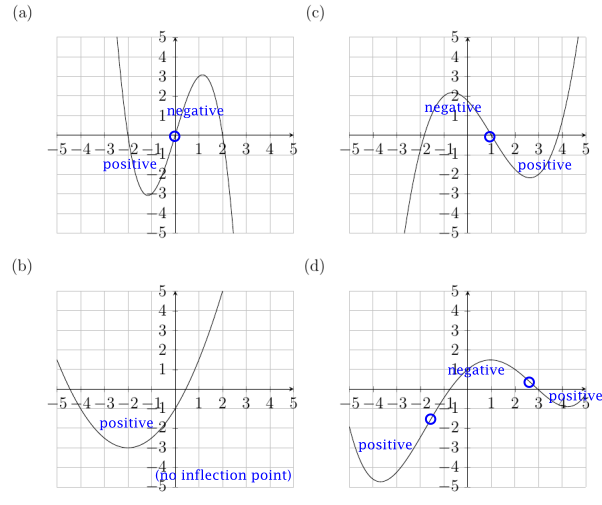- Given each [latex]f(t)[/latex], describe in one sentence the meaning of [latex]f'(t)[/latex].
- Let [latex]f(t)[/latex] be the distance (in miles) an astronaut is from the surface of the earth as he blasts off towards space. Here [latex]t[/latex] is measured in hours.
[latex]f'(t)[/latex] is the speed of the astronaut in miles per hourans
- Let [latex]f(t)[/latex] be the number of gallons of diesel gasoline in the tank of a truck, with [latex]t[/latex] measured in hours.
[latex]f'(t)[/latex] is how fast fuel is being burned, in gallons per minute. It could also represent how fast the fuel is being filled up at a gas station.ans
- Let [latex]f(t)[/latex] be the concentration of NaCl in parts per million within the cytoplasm of a cell. Here, [latex]t[/latex] is measured in minutes.
[latex]f'(t)[/latex] is the rate the concentration of NaCl is increasing in parts per million per minute.ans
- Let [latex]f(t)[/latex] be the speed of a runner (in feet per second), and let [latex]t[/latex] be measured in seconds.
[latex]f'(t)[/latex] is the acceleration of the runner, or the rate at which the runner’s speed is increasing in (feet per second) per second.ans
- Let [latex]f(t)[/latex] be the rate (in dollars per hour) that you are paid, where [latex]t[/latex] is measured in months.
[latex]f'(t)[/latex] is like how fast are you getting raises, measured in (dollars per hour) per month.ans
- Let [latex]f(t)[/latex] be the distance (in miles) an astronaut is from the surface of the earth as he blasts off towards space. Here [latex]t[/latex] is measured in hours.
- For each of the functions below, compute the derivative twice. That is, compute [latex]f'(t)[/latex], then take the derivative of [latex]f'(t)[/latex] to find [latex]f''(t)[/latex].
- [latex]f(t) = 5t^2 - 6t + 2[/latex]
[latex]10t - 6[/latex], [latex]10[/latex]ans
- [latex]f(t) = t^3 + e^t - \sqrt{t}[/latex].
[latex]3t^2 + e^t - 1/2 t^{-1/2}[/latex], [latex]6t + e^t + 1/4 t^{-3/2}[/latex]ans
- [latex]f(t) = \frac{1}{t}[/latex]
[latex]-t^{-2}, 2 t^{-3}[/latex]ans
- [latex]f(t) = \sin(t)[/latex]
[latex]\cos(t)[/latex], [latex](-\sin(t))[/latex]ans
- [latex]f(t) = (\sqrt{t} + 1)^2[/latex]
[latex]1 + t^{-1/2}[/latex], [latex]-\frac{1}{2} t^{-3/2}[/latex]ans
- [latex]f(t) = 5t^2 - 6t + 2[/latex]
- For each graph, circle any inflection points (if any). Label each region between the inflection points has having either a positive or negative second derivative.

ans
- A river bank is eroding. Let [latex]f(t)[/latex] be the metric tonnes of soil and rock material on day [latex]t[/latex]. Suppose [latex]f(t) = 0.05t^2 - 3t + 125[/latex] (this model is valid from [latex]t = 0[/latex] to [latex]t =30[/latex]) .
- What is [latex]f'(t)[/latex] measuring? What are the correct units?
How quickly soil and rock are being lost due to erosion in metric tonnes per day.ans
- Sketch the derivative.
- Find the derivative
[latex]0.1x - 3[/latex]ans
- How quickly is material being lost on day [latex]t = 5[/latex]? How quickly is material being lost on day [latex]t = 25[/latex]?
[latex]2.5[/latex] metric tons per day on day [latex]5[/latex], [latex]0.5[/latex] metric tons per day on day [latex]25[/latex].ans
- What is [latex]f'(t)[/latex] measuring? What are the correct units?
- The stock price for Math Nerds, Inc, over the course of an 8 hour trading day ([latex]t = 0[/latex] to [latex]t = 8[/latex]) is modeled by [latex]p(t) = -0.3t^3 + 3t^2 - 4t + 17[/latex] ([latex]p(t)[/latex] is measured in dollars).
- What is [latex]p'(t)[/latex] measuring? What is [latex]p''(t)[/latex] measuring? State the correct units for each.
[latex]p'(t)[/latex] is the rate of change of the stock price in dollars per hour. [latex]p''(t)[/latex] is how quickly the stock price rate is speeding up or slowing down, measured in dollars per hour[latex]^2[/latex]ans
- Sketch the graph of [latex]p'(t)[/latex] and [latex]p''(t))[/latex].
- Compute [latex]p'(t)[/latex] and [latex]p''(t)[/latex].
[latex]p'(t) = -0.9t^2 + 6t - 4[/latex], [latex]p''(t) = -1.8t + 6[/latex].ans
- How quickly is the stock gaining in price at [latex]t = 4[/latex]? How quickly is it losing value at [latex]t = 7[/latex]?
Gaining at 5.6 dollars per hour at [latex]t = 4[/latex], but losing at a rate of [latex]-6.1[/latex] dollars per hour at [latex]t = 7[/latex]ans
- At [latex]t = 4[/latex], the stock price is clearly growing. But is growth speeding up or slowing down? How can you use the formula for [latex]p(t)[/latex], [latex]p'(t)[/latex], or [latex]p''(t)[/latex] to find out?
We can plug [latex]t = 4[/latex] into [latex]p''(t)[/latex], to get an answer of [latex]-1.2[/latex] dollars per hour per hour, which means growth is slowing down.ans
- What is [latex]p'(t)[/latex] measuring? What is [latex]p''(t)[/latex] measuring? State the correct units for each.
- A tank has [latex]f(t)[/latex] liters of water at time [latex]t[/latex] measured in minutes, where [latex]f(t) = -2.2t^3 +27t^2- 120t + 500[/latex] (this model is valid [latex]t = 0[/latex] to [latex]t = 9[/latex]).
- Sketch the graphs of [latex]f'(t)[/latex] and [latex]f''(t)[/latex].
- What is [latex]f'(t)[/latex] measuring? What is the meaning of [latex]f''(t)[/latex]? Give the correct units.
Imagine water is leaking out of a hole. [latex]f'(t)[/latex] is indirectly measuring the size of that hole, since it is measuring how quickly water is being lost in liters per minute. [latex]f''(t)[/latex] would relate to how quickly the hole is opening or closing, thus measuring how fast the rate is changing in liters per minute per minute.ans
